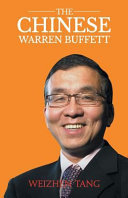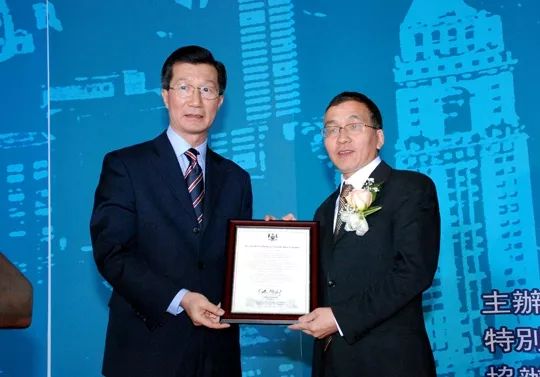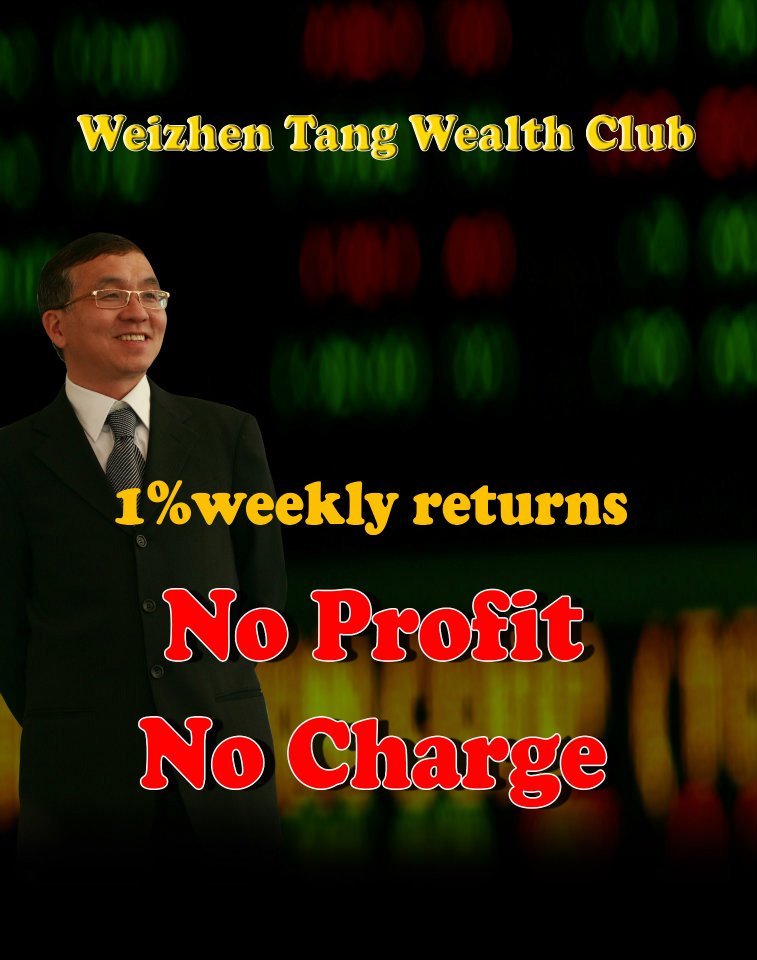The Keynote Speaker,
Weizhen Tang speak at the Second North America Chinese Wealth Summit
Respected Chairman Fang Sun, Madam Zhu, Professor Xu, Dr. Pattison,
Friends and guests, good afternoon to all of you!
Much thanks to the insightful speeches by the guest speakers. They have all talked about the disastrous outcomes that the recent financial crisis has presented. This economic turmoil, caused by greed and lack of risk management, has not only created chained collapses in the economy, but has also severely damaged the confidence of investors. In the face of this global disaster, I have grabbed hold of this once-in-a-century opportunity, using the 1% theory of financial investment to achieve yearly returns of 50%.
The topic that I would like to discuss you today is: Practice is the sole criterion for testing truth.
Weizhen Tang’s Market Maker Philosophy and Practice on Wealth Creation
In my book the Chinese Warren Buffett: King of 1% Weekly Returns, I wrote about Mao Zedong and Deng Xiaoping, two of my most respected figures. Practice being the only criterion for testing
theory was a key part of Mao’s thought and Deng’s theories. The market maker’s philosophy and the 1% solution are the product of my many years of investment practice, and they are constantly being tested, solidified and improved upon in practice. In the face of this economic turmoil, many talented investors have fled for fear of failure. Instead of following suit, we have firmly stood by the1% theory and relied on it as a guide to our investment practice, reaping consistent investment returns and suffering no losses. The reality has proven that the market maker’s philosophy and the 1% theory’s practicality is a gem for avoiding losses and obtaining high rate of returns.
- The origin and formation of the market maker philosophy and the 1% theory
As you all know, two decades ago, I started my career in biological research. Later, I entered the financial investment industry by chance. Without an educational background in finance, I was not bound by the teachings of investment books. However, I had the judgment and thinking of an intelligent investor. Rather than merely imitating the operating approaches of the world’s top- level masters, I studied their strategies and philosophy.
Initially, I was afraid of doing any investments. I didn’t think it was a proper business for me, and feared that I would lose all my funds in the end. After reading the works of the gurus, I understood that investment is an important part of the economic system, and that loss could be avoided. Therefore, from the very beginning, I have persistently pursued investments without loss that can generate steady nd continuous returns.
As a club investor, I paid full attention to market trends and the fluctuations of the target funds that I had invested. Just like most people, I bought in low and sold at high to make money. In the bull market days after I joined the industry, this strategy enabled me to reap considerable profits every day. Soon I started making investments for my friends. The success of the first endeavor made me happy and excited, and certainly attracted more and more people who approached me for asset management. Thus from the initial mutual fund speculations, I expanded into stocks, options, particularly index options, where accurate judgment of the market trend was required. Through close and careful observations of the market, I was able to develop an effective way to handle the fluctuations and to avoid risks as much as possible. However, due to the fact that one way trading of index options put our investments at a serious disadvantage in the market, I eventually realized that mutual funds would be a much more reliable investment vehicle than stocks and options. It took me about two years to explore the market while making substantial returns for my clients. In the end, I decided to devote my career to the cause of financial investment.
Unfortunately, banks and mutual fund companies later changed their rules and regulations regarding mutual fund speculations. As a result, I had to look for alternatives, such as market indexes and foreign exchange, to continue my investments. Needless to say, there was a sharp increase in my operating difficulty and costs. Faced with a bear market, I was at a total loss. This phase, without a doubt, has proven to be the most challenging and darkest time of my life.
Despite the pains of great financial and personal loss in those days, I never stopped exploring the investment philosophy and strategy of Warren Buffett. I came to understand that the Buffett way of investment is to take the market maker’s position to uphold stability. Being always on the alert against loss and having the interest of investors at the foremost, he ties the interests of his clients with those of his own closely.
In 2004, I published an article about my perceptions of Warren Buffett’s secrets of success. The article took the fancy of the chairman of the Asia Pacific Presidents Association. As a result, they invited me to China as a distinguished guest to attend the Philosophy & Practices of the World’s Greatest Investor, Warren buffet Forum, from which I learned a lot and inspired. Then, I started to write my own book The Chinese Warren Buffett, and in the process of writing, my focus of attention and study shifted from pure investments and speculations to the theories of wealth accumulation and my own positioning in the market. I turned from learning the specific operation skills to studying the principles of risk control and management. Thus from understanding Warren Buffett’s path of success, I discovered my own way to reach financial prosperity.
What I learned from the adversity made me understand that continuous and consistent returns without loss are fundamental to the accumulation of wealth, that the key to operational success is to seek the market maker’s position, recognize and take advantage of the normal volatilities of the market, lower risks, turn minor daily profits into continuous and steady weekly profits and grow the compound profits into remarkable annualized returns.
Thus “investing without loss” became a motto I’ve put on heart and into actions. Instead of dreaming of reaching wealth overnight, I started surefooted operations, using indexes and foreign exchange as operation vehicles. Eventually, I prevailed over my adversity and truly came into my own, as I am able to create continuous and consistent investment returns for my clients.
Since then, there has been a rapid growth of my clientele. In the first North American Chinese Wealth Summit held in Toronto in 2006, I formally raised my own ideas about investment. Then I summarized my theories and practice and included them in my book. Within three years, my clients grew from ten to more than 200, The funds under my management increased from the initial one million dollars to the current 70 million dollars. I believe that my clients appreciate my philosophy of risk control and management more than they trust my investment operation skills.
- The Market Maker’s Philosophy and the 1% Theory and Practice
In the second edition of my book The Chinese Warren Buffet, I detailed my 1% theory. Firstly, there must be the mentality of a market maker and persistent efforts to pursue it. Good performance is necessary for gathering large amounts of capital. Study, but not imitate, Buffet’s wealth management theories in the position of a market maker. As for myself, I used short-term speculations as my investment strategy.
While I only make use of 1% daily to pursue a 0.2% return, 99% of the total investment funds are safe from any potential market dangers, thus significantly lowering the level of risk.
1% is a vital figure of wealth; it is extremely valuable and carries great meaning. The magnitude, risk, returns and wealth of 1% seems very minute and simple, but its significance is unparalleled. Only with the recognition of 1% does one come upon success and fortunes, and fully avoid the oncoming disasters brought on by the economic crisis. Why is 1% such a useful and important number? Because it is the full integration of market concepts and the market maker position, and therefore it is the trump of business success. It is the border of wealth, and key to success or failure. A firm hold on the 1% theory translates to certain wealth. As it is only within the 1% magnitude that investors make profits, only those who have control of the 1% solution can earn on the market. If only 1% of people can really profit from the market, then the other 99% should avoid losses by not entering the market, and putting their funds in the hands of the successful 1%. That way, everyone can maximize their earnings, and fulfill his own value.
1% is never impossible, only unthinkable, or made unattainable by a lack of patience. Fully recognizing wealth is an incremental and slow process. 1% is a very small starting point, and we start from small, start from easy, and accumulate to a considerable size, the accumulation which will eventually enable us to reach the peak of wealth.
By lowering the difficulty level significantly and approaching investments with reason and a casual attitude, one avoids greed and being engrossed by investment returns. Arrogance in chasing the excitement of investments will only bring losses.
In the 3rd edition of my book The Chinese Warren Buffet, I revisited the 1% theory, this time with more detail.
I operate on the short-term strategy. Upon recognition that the daily activity on the market hovers around 1%, I set my weekly returns target to 1%, and further set a 0.2% daily target. A small goal is easily attainable, and what’s more important is the control over risks that it brings. Daily returns of 0.2% translate to 1% per week, 4% per month and 50% returns per year, eventually a significant figure.
Foreign exchange and market indexes are my primary vehicles of operation. As there is always a relative quantity in the FOREX market, I will watch for chances in the fluctuations, sufficient funds in hand. My overall strategy is to fight a protracted war , but in tactics, I adopt a blitzkrieg strategy to win every battle.
I have fully announced the experience of my successes. I hope my colleagues can comprehend my theories and apply them in practice in their respective fields. Currently, many people have successfully replicated my investment model. This further proves the theory’s practicality and applicability.
3..Security in Weizhen Tang’s Financial Investments
The ongoing financial crisis has caused many investment organizations and individuals great losses. However, it has brought us a vital development opportunity. Firstly, our lacks of losses and consistency in returns during these times have been brought to the attention of more and more people. However, with these recent economic troubles, many seemingly infallible banks and investment organizations have suffered losses or forced into closure. Society has lost confidence in the financial investment industry, and some investors and individuals in the community have harboured doubts about our investments.
To alleviate the doubts of investors, I have, on numerous occasions, held demonstrations of my investment strategies. On the 26th of this month, I will hold a week-long real-time demonstration, proving in practice that my returns on investment are gained on the market.
The theoretical foundation of my investment strategies is the 1% solution. In layman’s terms, it means that I only put to use 1% of the total funds on the market, pursuing daily returns of 1%. In general, there is no use of leverage, but in specific operations, I seek the maximum leverage to accumulate wealth by small daily increments, but minimize the risk levels.
I have chosen the macro markets, such as foreign exchange and market indexes, for my investments, all because they are less subject to being controlled by a particular organization, so as to evade the risks effectively. In addition, based on the experience and lessons I learned from the past practices and mistakes, I have also adopted a variety of technical measures of risk control on the operation level
As for 90% of the investment funds under my management, I have dispersed them for secure storage, including investing in government bonds which are highly secure.
After I made the 1% theory and solution public, a number of investors have applied it in their practices and received positive results. They say, the strategy has worked well in terms of risk control. Compared with me, Bernard Madoff obviously lacked an effective system of risk control in his investments. This is another major difference between my investments and his.
In my 15 years of exploration and practice in the financial industry, I have experienced success in the initial days, adversities and frustrations in the mid phase, and take-off in the recent years. Through an account of these experiences in the book, I hope to tell the readers about my past mistakes and lessons that I learned, so that other investors will not repeat what I didn’t do well before.
Today, my investment cause has been revitalized. As for those clients who had suffered financial loss in their previous investments with me, I have managed to make up their loss by
paying back their investment principal. I firmly believe that a successful business person has to be a reliable and trustworthy person first.
The 1% solution is more of a theory on risk control than one on financial profitability. It enables retail investors to become market makers and turns the less influential market makers into more powerful ones. If applied to the huge foreign exchange reserve of China, the 1% solution is sure to take the financial investment industry of China to the world and generate enormous wealth for the Chinese people.
Let’s work to add a Chinese flavor to the world of finance.
I’d like to take the opportunity to extend my sincere gratitude to Mr. Sun for his attendance to the Summit and his support, to Dr. John Pattison for his excellent speech, to Professor Xu for all the precious help he has given me over the years and to all of my clients for their trust in me. My gratitude also goes to the media and the staff who have worked so hard to make this Summit come true. Finally, I want to thank my wife, Hong Xiao, for her understanding and support of my work.
I wish everyone all the best and Happy New Year.
Thank you!
Why are 99% of people failing in day trading?
Tom Costello
CEO of Clairety Inc.
Author of “The Front Office” A
Hedge Fund Guide for Retail, Day Traders, and Aspiring Quants
Why are 99% of people failing in day trading?
I don’t know for certain that 99% is the right number, but I suppose it’s close enough. If what you want to know is why you specifically are failing at day trading, then the answer is the Dunning Kruger effect. You know so little about how markets work that you are incapable of assessing your own lack of competence. In reading something like that you may say: “This doesn’t apply to me, I know TONS about the markets.” To that I’d respond – “Exactly!” You believe you know tons about the markets and how they work. But most of what you know is nonsense taught to you by people who didn’t know anything either, and like you, they lacked a clear view of their lack of competence. It’s breathtaking really – the degree of Dunning Kruger in the retail markets. I can think of no other domain that comes close to it. What’s even worse is that they hear things like Goldman Sachs making money on 299 of every 300 days (which is absolutely true) and their immediate response is “they must be cheating”. They aren’t. At least not in the way that anyone in the retail world might imagine.
All they’re doing is using ‘positive cash flow hedging’ to make sure that they can turn a profit if the markets go up, if they go down, and if they stay the same. That’s it. But rather than thinking to themselves “well now I know that’s possible, I’m going to try to learn the same thing” retail traders just say “It’s the big banks cheating”, or “they’re front running me”, or “they’re manipulating the market”, or “It’s the Rothchilds, the Getty’s, Colonel Sanders and the Queen who are screwing me!” or some other stupidity. Making money in the markets isn’t really that hard. Making more money than everyone else,
that’s hard. But just turning a profit? It’s quite simple really. You just have
to be something other than a narcissistic, vain, shallow, self aggrandizing
dolt. Just think seriously about it for even a little bit. Just be motivated by
something other than proclaiming yourself the coolest kid on social media. Don’t be an idiot. Don’t do ‘stupid’ things.






free online dating websites https://freedatingsiteall.com
Excellent beat ! I would like to apprentice even as you
amed your site, how could i subscribe forr a blog weeb site?
Thhe account helped me a applicable deal. I were tiny bit familiar of this your broadcast offered vibrant transparent concept
https://www.producthunt.com/posts/otsimo-school
eessay online
essay online https://teslamotorsclub.com/